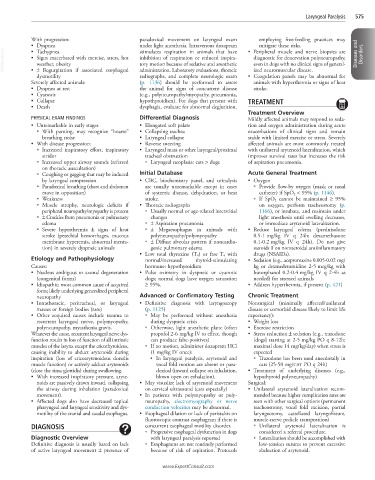Page 1153 - Cote clinical veterinary advisor dogs and cats 4th
P. 1153
Laryngeal Paralysis 575
With progression: paradoxical movement on laryngeal exam employing free-feeding practices may
mitigate these risks.
• Dyspnea under light anesthesia. Intravenous doxapram • Peripheral muscle and nerve biopsies are
VetBooks.ir • Signs exacerbated with exercise, stress, hot inhibition of respiration or reduced inspira- diagnostic for denervation polyneuropathy, Diseases and Disorders
stimulates respiration in animals that have
• Tachypnea
tory motion because of sedative and anesthetic
even in dogs with no clinical signs of general-
weather, obesity
ized neuromuscular disease.
• ± Regurgitation if associated esophageal
radiographs, and complete neurologic exam
dysmotility administration. Laboratory evaluations, thoracic • Coagulation panels may be abnormal for
Severely affected animals: (p. 1136) should be performed to assess animals with hyperthermia or signs of heat
• Dyspnea at rest the animal for signs of concurrent disease stroke.
• Cyanosis (e.g., polyneuropathy/myopathy, pneumonia,
• Collapse hypothyroidism). For dogs that present with TREATMENT
• Death dysphagia, evaluate for abnormal deglutition.
Treatment Overview
PHYSICAL EXAM FINDINGS Differential Diagnosis Mildly affected animals may respond to seda-
• Unremarkable in early stages • Elongated soft palate tion and oxygen administration during acute
○ With panting, may recognize “hoarse” • Collapsing trachea exacerbations of clinical signs and remain
breathing noise • Laryngeal collapse stable with limited exercise or stress. Severely
• With disease progression: • Reverse sneezing affected animals are most commonly treated
○ Increased inspiratory effort, inspiratory • Laryngeal mass or other laryngeal/proximal with unilateral arytenoid lateralization, which
stridor tracheal obstruction improves survival rates but increases the risk
○ Increased upper airway sounds (referred ○ Laryngeal neoplasia: cats > dogs of aspiration pneumonia.
on thoracic auscultation)
○ Coughing or gagging that may be induced Initial Database Acute General Treatment
by laryngeal compression • CBC, biochemistry panel, and urinalysis • Oxygen
○ Paradoxical breathing (chest and abdomen are usually unremarkable except in cases ○ Provide flow-by oxygen (mask or nasal
move in opposition) of systemic disease, dehydration, or heat catheter) if SpO 2 < 95% (p. 1146).
○ Weakness stroke. ○ If SpO 2 cannot be maintained ≥ 95%
○ Muscle atrophy, neurologic deficits if • Thoracic radiographs on oxygen, perform tracheostomy (p.
peripheral neuropathy/myopathy is present ○ Usually normal or age-related interstitial 1166), or intubate, and maintain under
○ ± Crackles from pneumonia or pulmonary changes light anesthesia until swelling decreases,
edema ○ ± Aspiration pneumonia or immediate arytenoid lateralization.
○ Severe hyperthermia ± signs of heat ○ ± Megaesophagus in animals with • Reduce laryngeal edema (prednisolone
stroke (petechial hemorrhages, mucous polyneuropathy/polymyopathy 0.5-1 mg/kg IV q 24h; dexamethasone
membrane hyperemia, abnormal menta- ○ ± Diffuse alveolar pattern if noncardio- 0.1-0.2 mg/kg IV q 24h). Do not give
tion) in severely dyspneic animals genic pulmonary edema steroids if on nonsteroidal antiinflammatory
• Low total thyroxine (T 4 ) or free T 4 with drugs (NSAIDs).
Etiology and Pathophysiology normal/increased thyroid-stimulating • Sedation (e.g., acepromazine 0.005-0.02 mg/
Causes: hormone: hypothyroidism kg or dexmedetomidine 2-5 mcg/kg with
• Nucleus ambiguus or axonal degeneration • Pulse oximetry in dyspneic or cyanotic butorphanol 0.2-0.4 mg/kg IV q 2-4h as
(congenital forms) dogs; normal dogs have oxygen saturation needed) for stressed animals
• Idiopathic: most common cause of acquired ≥ 95%. • Address hyperthermia, if present (p. 421)
form; likely underlying generalized peripheral
neuropathy Advanced or Confirmatory Testing Chronic Treatment
• Intrathoracic, peritracheal, or laryngeal • Definitive diagnosis with laryngoscopy Nonsurgical (minimally affected/unilateral
masses or foreign bodies (rare) (p. 1125) disease or comorbid disease likely to limit life
• Other acquired causes include trauma to ○ May be performed without anesthesia expectancy):
recurrent laryngeal nerve, polymyopathy, during dyspneic crisis • Weight loss
polyneuropathy, myasthenia gravis. ○ Otherwise, light anesthetic plane (often • Exercise restriction
Whatever the cause, recurrent laryngeal nerve dys- propofol 2-6 mg/kg IV to effect, though • Stress reduction ± sedation (e.g., trazodone
function results in loss of function of all intrinsic can produce false-positives) [dogs] starting at 2-5 mg/kg PO q 8-12h;
muscles of the larynx except the cricothyroideus, ○ If no motion, administer doxapram HCl maximal dose 14 mg/kg/day) when stress is
causing inability to abduct arytenoids during (1 mg/kg IV once): expected
inspiration (loss of cricoarytenoideus dorsalis ■ In laryngeal paralysis, arytenoid and ○ Trazodone has been used anecdotally in
muscle function) or actively adduct arytenoids vocal fold motion are absent or para- cats (25-50 mg/CAT PO q 24h)
(close the rima glottidis) during swallowing. doxical (inward collapse on inhalation, • Treatment of underlying diseases (e.g.,
• With increased inspiratory pressure, aryte- blown open on exhalation). hypothyroid polyneuropathy)
noids are passively drawn inward, collapsing • May visualize lack of arytenoid movement Surgical:
the airway during inhalation (paradoxical on cervical ultrasound (cats especially) • Unilateral arytenoid lateralization recom-
movement). • In patients with polymyopathy or poly- mended because higher complication rates are
• Affected dogs also have decreased topical neuropathy, electromyography or nerve seen with other surgical options (permanent
pharyngeal and laryngeal sensitivity and dys- conduction velocities may be abnormal. tracheostomy, vocal fold excision, partial
motility of the cranial and caudal esophagus. • Esophageal dilation or lack of peristalsis on laryngectomy, castellated laryngofissure,
fluoroscopic contrast esophagram if there is muscle-nerve pedicle transposition)
DIAGNOSIS concurrent esophageal motility disorder. ○ Unilateral arytenoid lateralization is
○ Progressive esophageal dysfunction in dogs considered a referral procedure.
Diagnostic Overview with laryngeal paralysis reported ○ Lateralization should be accomplished with
Definitive diagnosis is usually based on lack ○ Esophagrams are not routinely performed low-tension sutures to prevent excessive
of active laryngeal movement ± presence of because of risk of aspiration. Protocols abduction of arytenoid.
www.ExpertConsult.com

